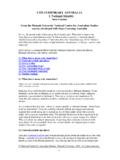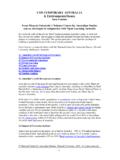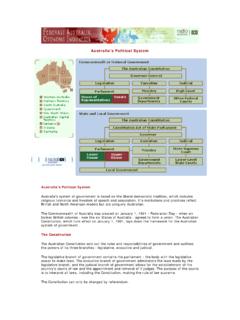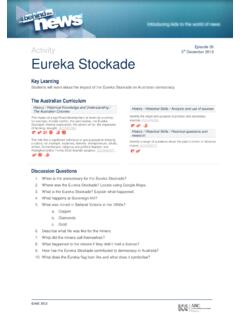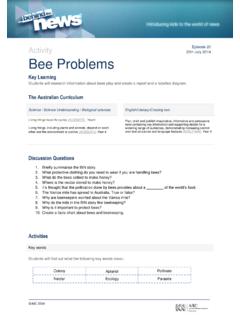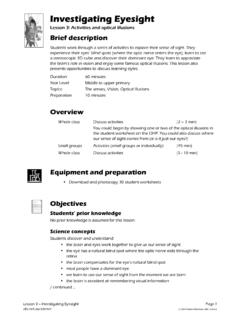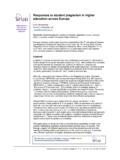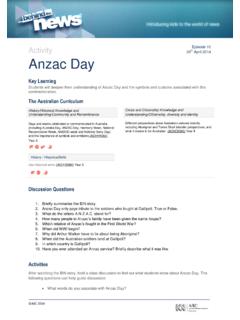Transcription of Australia’s Political System
1 australia s Political System australia 's Political System australia 's System of government is based on the liberal democratic tradition, which includes religious tolerance and freedom of speech and association. It's institutions and practices reflect British and North American models but are uniquely Australian. The commonwealth of australia was created on January 1, 1901 - Federation Day - when six former British colonies - now the six States of australia - agreed to form a union. The Australian constitution , which took effect on January 1, 1901, lays down the framework for the Australian System of government. The constitution The Australian constitution sets out the rules and responsibilities of government and outlines the powers of its three branches - legislative, executive and judicial.
2 The legislative branch of government contains the parliament - the body with the legislative power to make laws. The executive branch of government administers the laws made by the legislative branch, and the judicial branch of government allows for the establishment of the country's courts of law and the appointment and removal of it judges. The purpose of the courts is to interpret all laws, including the constitution , making the rule of law supreme. The constitution can only be changed by referendum. australia 's Constitutional Monarchy australia is known as a constitutional monarchy. This means it is a country that has a queen or king as its head of state whose powers are limited by a constitution .
3 australia 's head of state is Queen Elizabeth II. Although she is also Queen of the United Kingdom, the two positions now are quite separate, both in law and constitutional practice. In practice, the Queen is plays no role within the Australian Political System and is merely a figurehead. In australia , the Queen is formally represented by a Governor General whom she appoints on the recommendation of australia 's Prime Minister. The Queen plays no role in the day-to-day duties of the Governor General. The Governor General and State Governors While recognised as the Queen's representative, the Governor General is in no way subject to the direction, supervision or veto of the Queen or the British Government.
4 Under the constitution , the Governor-General's powers and duties include summoning, proroguing and dissolving Parliament, assenting to Bills, appointing Ministers, setting up Departments of State and appointing judges. By convention, however, the Governor-General acts only on the advice of Ministers in virtually all matters and the appointee to the office is selected on the advice of the Government. The six State Governors perform similar roles in their States. The commonwealth or National Government The National Parliament is bicameral, having two chambers: the House of Representatives (Lower House) and the Senate (Upper House). Both are responsible for national laws, such as: trade, taxation, immigration, citizenship, social security, industrial relations and foreign affairs.
5 Legislation has to be approved by both houses before it can become law. The House of Representatives, initiates most legislation. It currently has 148 elected members, each representing around 80,000 voters. The Political party or parties with the most seats in the House of Representatives forms the Government. The Senate is known as the 'house of review'. Proposed legislation is generally considered clause-by-clause and often referred to committees. One of the Senate's original roles was to ensure that laws were fair to all states. Voters therefore elect 12 Senators from each State and two Senators from each of australia 's two Territories. State and Territory Governments State and Territory Governments are responsible for those powers not administered by the commonwealth Government.
6 Every State and Territory has its own Parliament and its own constitution Act (which can be amended by its Parliament), but they are also bound by the national constitution . commonwealth law also overrules State laws where the law is within the Constitutional powers of the commonwealth . All State Parliaments other than Queensland are bicameral with an Upper and Lower House. The Parliament of each Territory has only one House. State and Territory governments are responsible for matters which include: public health, education, roads, public land use, police, fire and ambulance services and local government within their own States or Territories. Local Government There are approximately 900 local government bodies in australia .
7 The powers of local government vary from State to State and are the responsibility of State Governments. Some local government bodies operate transport and energy enterprises. Most levy rates as well as receiving funding from the higher tiers of government. Local government responsibilities typically include town planning, supervision of building codes, local roads, water, sewerage and drainage, waste and sanitary services, and community recreational facilities. Relations between levels of Government The commonwealth and State Governments co-operate in many areas where States and Territories are formally responsible, such as education, transport, health and law enforcement.
8 Income tax is levied federally, and debate between the levels of governments about access to revenue is a perennial feature of Australian politics.
